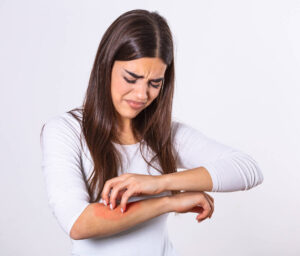We spend the majority of our time outdoors in the summer as the daylight hours are longer. However, your skin may be affected by extreme heat, humidity, and air conditioning. It involves tanning of the skin, acne, wrinkles, dark spots and many more. But a common skin problem in the scorching summers is heat rash, also known as prickly heat.
In this blog we will discuss this skin problem in detail. Also, what are the symptoms of heat rash? How can we treat the same? How can we avoid this problem in future? What are the products used for the same?
What is a Heat Rash (Prickly Heat)?
Heat rash or prickly heat is an uncomfortable skin irritation in hot and humid climates. The medical name for heat rash is miliaria. This skin issue is caused when sweat glands become clogged and they trap sweat under the skin. This blockage leads to inflammation, thus, developing red, itchy and irritated rashes on the skin.
A rash can be in the form of tiny blisters or pimples. People who sweat more or are living in a humid climate are likely to have heat rash on their skin. Also, children and babies are more prone to it as their sweat glands are in the developing stage.
Identify Your Rash

Heat rashes most often appear on the body parts that don’t get enough ventilation (airflow) and are in skin to skin contact. It also develops on the places where clothes rub against skin. When heat rash develops, you may identify it by looking at your skin when it is:
- Swollen with red bumps
- Tiny blisters or pimples
- Fluid filled blisters
The most common sites of heat rashes are:
- Neck
- Arms and legs
- Underarms
- Groin
- Underneath your breasts
- Inner thighs
- Back
Symptoms & Causes of Heat Rash
After you start sweating, heat rashes start to form within some time. The area of your skin will first start to appear red in color. Then small bumps or blisters will come on the affected area. Other symptoms of heat rash include:
- Mild to severe itching
- Swollen or inflamed skin around the rash
- Red colored blisters or pimples
- Mild pain to slight burning sensation
- Severe pain or discomfort
- Pus or fluid filled bumps
The main cause of heat rash is clogging of the sweat glands. This will create inflammation and thus form rashes on the skin. Other causes include:
- Sweat glands get blocked with dead skin cells
- Sweat accumulates too much between your skin and your clothes
- Sweat glands are blocked by hair follicles
- Hormone changes in both male and female
- Not enough airflow between clothing and your skin
Duration of Heat rash and Does It spread?
Heat rash usually lasts for about 3-4 days. It goes away with the application of proper creams, ointments and therefore, inflammation generally gets reduced. If the heat rashes don't fade away, consult your doctor for the same.
Heat rash may spread to other parts of the body too. This is due to the clogged sweat glands. Rashes are more likely to spread on other body parts where your clothes are more tight. However, rashes will not spread to other people.
Heat Rash Treatment
Heat rash will clear up on its own in a few days after giving proper treatments. Some of the treatment options available for prickly heat rash are:
Oral Antihistamines
A class of medications known as antihistamines is used to treat allergies or inflammation. For heat rash, you can use OTC (over-the-counter) antihistamine tablets like cetirizine, loratadine, and fexofenadine.
Talcum Powder
Heat rash can be treated with prickly heat powder. It includes cooling ingredients like menthol and camphor, essential oils like sandalwood, rose, peppermint, neem, and kaolin. This helps in assisting relief from heat rash.
Moisturisers and Lotions
On heat rash, you can apply
Kosmoderma Moisture Boost cream. It is made of ceramides and hyaluronic acid that provides a soothing effect to the burning sensation from heat rash. It instantly provides hydration to the affected area and makes your skin free from irritation.
Prickly Heat Rash Home Remedies

For heat rash, there are some remedies people can do at home to help relieve itching and cool the skin. Some of them are:
Cold compress
Cooling down the skin is one of the finest techniques to treat heat rash. To reduce redness and itching from heat rash, you may apply an ice pack or cold cloth on the affected area of the skin. When using an ice pack, be sure to wrap it in a towel or cloth to protect the skin. You may keep an ice pack for 5-10 minutes.
Wear loose cotton clothes
Wearing loose clothes allows air to circulate through the body. Therefore, wear lightweight clothes made of cotton and avoid synthetic fabric clothes so as to reduce prickly heat rashes on your skin.
Aloe vera
Aloe vera is a calming, hydrating, and anti-inflammatory ingredient. Apply aloe vera gel or freshly extracted aloe vera on skin affected by heat rash.
Baking soda
Baking soda is used to soothe itching and irritation of the skin. Add 3- 5 tablespoons of baking soda to lukewarm water and soak for about 20 minutes. Apply this mixture on the affected areas.
How to Avoid a Prickly Heat Rash?
The best way to prevent heat rash is to avoid heat, humidity and sweating. The other ways to avoid prickly heat rash is:
- Avoid applying thick creams or lotions on your skin throughout the summer
- Stay indoors in a cool environment and drink plenty of water.
- Avoid hard exercises in summers
- Wear loose lightweight clothing made of cotton fabric
- Keep your skin dry by using towel frequently to soak sweat
- Post workout, always take a shower
What to Avoid When You Have a Prickly Heat Rash?
Avoid hot, humid surroundings that can cause excessive sweating to help prevent heat rash. Also, avoid vigorous exercise when it is warm outside. Try to wear only cotton clothes as it is good absorbent material. Avoid wearing synthetic and tight fitting clothing.
Consult With a Dermatologist If Necessary
Prickly heat rash usually goes away in 3-4 days. Having fever, pain, and pus in the rashes, is a serious condition. In some cases, heat rash may turn into an infection with severe swelling. Therefore, if all these above symptoms persist, it is necessary to consult a dermatologist for the same.


